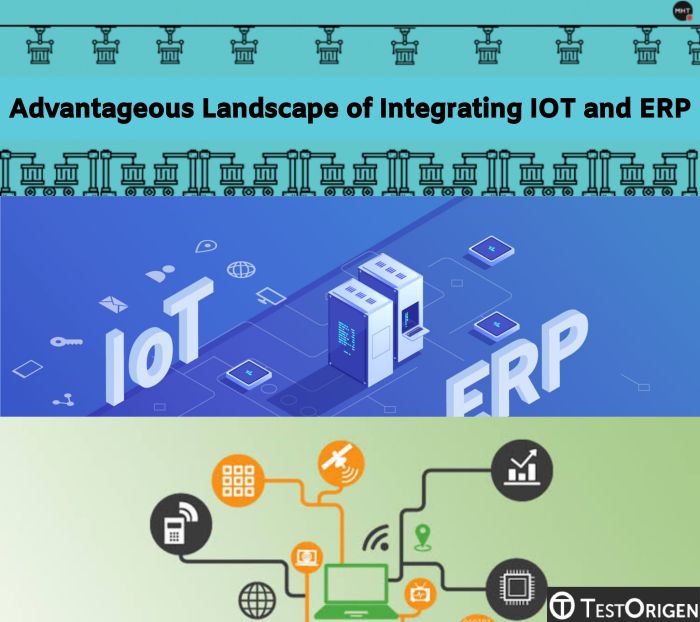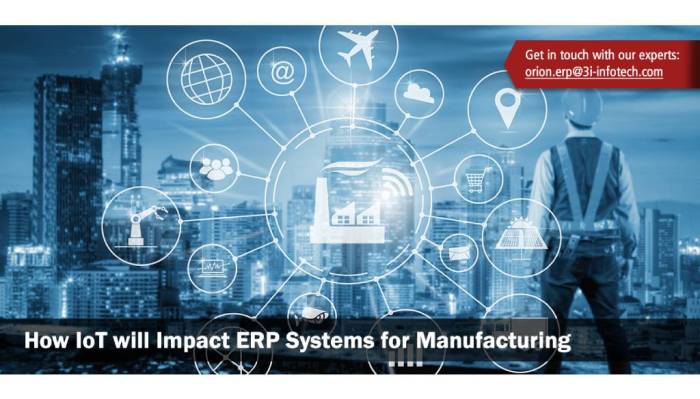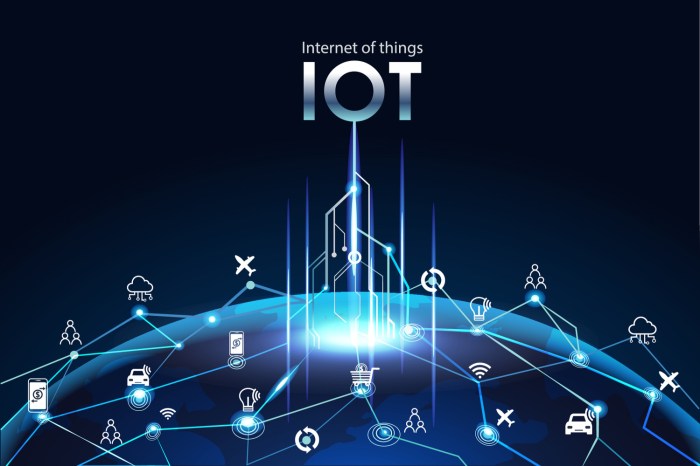IoT Transforms ERP Systems into More Proactive and Real-Time Solutions is a compelling narrative exploring the powerful synergy between the Internet of Things (IoT) and Enterprise Resource Planning (ERP) systems. Traditional ERP systems often struggle with real-time data processing and proactive decision-making, relying on batch processing and lagging indicators. However, the integration of IoT data streams offers a transformative potential, enabling businesses to move beyond reactive responses to truly proactive and data-driven strategies.
This integration unlocks a wealth of opportunities for improved efficiency, reduced costs, and enhanced decision-making across various industries.
This exploration delves into the methods for acquiring and integrating IoT data into existing ERP infrastructure, examining various communication protocols and data transformation processes. We will then analyze how real-time data processing, including stream processing techniques, facilitates improved inventory management and predictive maintenance. Furthermore, we will discuss the crucial aspects of security and scalability in building a robust and reliable IoT-ERP integration solution, culminating in a review of successful case studies across diverse sectors.
IoT and ERP System Integration: A Powerful Partnership
The convergence of the Internet of Things (IoT) and Enterprise Resource Planning (ERP) systems marks a significant leap forward in operational efficiency and data-driven decision-making. IoT, encompassing a vast network of interconnected devices capable of collecting and exchanging data, provides a wealth of real-time information. ERP systems, on the other hand, manage and integrate core business processes, including planning, purchasing, inventory, sales, marketing, finance, and human resources.
Traditionally, ERP systems have relied on batch processing and scheduled updates, resulting in delayed insights and limited proactive capabilities. Integrating IoT data into ERP systems overcomes these limitations, enabling real-time visibility, predictive analytics, and automated responses to dynamic business conditions.
Understanding the Fundamentals
IoT devices, ranging from sensors and actuators to smart machines and wearables, generate massive amounts of data about the physical world. This data, when properly integrated, offers unparalleled insights into operational processes. ERP systems, meanwhile, serve as the central nervous system of an organization, managing and coordinating various business functions. The integration of these two systems allows for a seamless flow of data from the shop floor or field to the executive suite, empowering businesses with actionable intelligence.
Traditional ERP systems often struggle with real-time data processing and proactive decision-making. Their reliance on scheduled updates and batch processing leads to delays in identifying critical issues and responding to changing circumstances. The integration of IoT data transforms this paradigm, enabling proactive interventions and improved operational efficiency.
The potential benefits of integrating IoT data into ERP systems are substantial. These include improved inventory management, predictive maintenance, enhanced supply chain visibility, optimized resource allocation, and reduced operational costs. By connecting the physical and digital worlds, organizations can gain a competitive edge through data-driven insights and automation.
IoT Data Acquisition and Integration, How IoT Transforms ERP Systems into More Proactive and Real-Time Solutions

Several methods exist for collecting data from IoT devices and integrating it into existing ERP infrastructure. This involves choosing appropriate communication protocols, designing robust data pipelines, and implementing data cleansing and transformation processes. Effective integration ensures data accuracy and compatibility with the ERP system.
Different communication protocols cater to various IoT device needs and network conditions. MQTT (Message Queuing Telemetry Transport) is lightweight and ideal for high-volume, low-latency data transmission, while CoAP (Constrained Application Protocol) is optimized for resource-constrained devices. Other protocols, such as AMQP (Advanced Message Queuing Protocol) and HTTP, may also be employed depending on the specific requirements.
| Step | Technology | Description | Potential Challenges |
|---|---|---|---|
| 1. Data Source Identification | IoT Device Discovery Tools | Identify all relevant IoT devices and their data output capabilities. | Device heterogeneity, compatibility issues. |
| 2. Protocol Selection | MQTT, CoAP, AMQP, HTTP | Choose the appropriate communication protocol based on device capabilities and network conditions. | Protocol compatibility, security considerations. |
| 3. Data Ingestion | Message Brokers (e.g., Kafka, RabbitMQ), Cloud Platforms (e.g., AWS IoT Core, Azure IoT Hub) | Collect data from IoT devices and store it temporarily. | Data volume, scalability, data loss. |
| 4. Data Transformation | ETL (Extract, Transform, Load) Tools | Cleanse, transform, and validate the data to ensure compatibility with the ERP system. | Data inconsistencies, data quality issues. |
| 5. Data Integration | APIs, middleware | Integrate the transformed data into the ERP system. | API limitations, integration complexity. |
Data cleansing and transformation are crucial for ensuring data accuracy and compatibility. This involves handling missing values, correcting errors, and converting data formats to align with the ERP system’s requirements. Data validation rules should be implemented to identify and reject invalid data entries.
Real-Time Data Processing and Analysis for Enhanced Efficiency

Real-time IoT data significantly enhances inventory management by providing up-to-the-minute visibility into stock levels, location, and movement. This allows for timely replenishment, reducing stockouts and minimizing storage costs. For instance, sensors tracking inventory levels can automatically trigger reordering processes when stock falls below a predefined threshold.
Predictive maintenance leverages IoT data to anticipate equipment failures before they occur. Sensors monitor machine performance parameters, identifying anomalies that indicate potential problems. This information is fed into the ERP system, triggering maintenance alerts and scheduling preventative maintenance activities, reducing downtime and extending equipment lifespan. For example, a manufacturing plant might use sensors to monitor vibration levels in its machines.
Abnormal vibration patterns could signal impending failure, prompting proactive maintenance before production is disrupted.
Stream processing offers real-time analysis of incoming data, providing immediate insights for decision-making. Batch processing, on the other hand, processes data in batches at scheduled intervals, leading to delays in analysis. The choice between these approaches depends on the specific requirements of the application. For applications requiring immediate responses, stream processing is preferred. For less time-sensitive analyses, batch processing may be sufficient.
Proactive Decision-Making and Automation Through IoT Integration

Integrating IoT data into ERP systems improves several key performance indicators (KPIs). These include reduced inventory holding costs, minimized downtime, optimized production schedules, improved customer satisfaction, and enhanced supply chain efficiency. The real-time visibility provided by IoT data enables proactive interventions, leading to significant improvements in these metrics.
A workflow demonstrating real-time IoT insights triggering automated actions might involve sensors monitoring production line speed. If the speed falls below a certain threshold, the system automatically sends an alert to the maintenance team and adjusts production schedules to compensate for the slowdown. Similarly, low stock levels detected by sensors could automatically trigger a purchase order.
- Improved operational efficiency through real-time monitoring and control.
- Reduced costs by minimizing waste, downtime, and inventory holding costs.
- Enhanced decision-making based on accurate and timely data.
- Increased agility and responsiveness to changing market conditions.
- Improved customer satisfaction through better service delivery.
Security and Scalability Considerations in IoT-ERP Integration
Integrating IoT devices into ERP systems introduces security challenges, including data breaches, unauthorized access, and denial-of-service attacks. Mitigation strategies involve implementing robust security protocols, such as encryption, authentication, and access control. Regular security audits and penetration testing are also crucial.
A scalable and reliable IoT-ERP integration solution requires a well-defined architecture. This includes using cloud-based platforms for data storage and processing, employing microservices for modularity and scalability, and implementing robust error handling and fault tolerance mechanisms. A distributed architecture ensures high availability and resilience.
- Implement strong authentication and authorization mechanisms for all IoT devices and users.
- Use encryption to protect data in transit and at rest.
- Regularly update firmware and software to patch security vulnerabilities.
- Implement intrusion detection and prevention systems.
- Conduct regular security audits and penetration testing.
Illustrative Case Studies of Successful Implementations
Numerous organizations across various industries have successfully implemented IoT-enhanced ERP systems. These implementations demonstrate the transformative potential of integrating IoT data into core business processes. Successful implementations often involve a phased approach, starting with a pilot project to test the integration and refine the processes before a full-scale deployment.
In the manufacturing sector, a leading automotive manufacturer integrated IoT sensors into its assembly line to monitor production efficiency. Real-time data on machine performance, material usage, and worker productivity enabled proactive adjustments to production schedules, reducing downtime and improving output. This resulted in a significant reduction in production costs and improved product quality.
- Manufacturing: Improved production efficiency, reduced downtime, and enhanced product quality through real-time monitoring of machine performance and material usage.
- Supply Chain: Enhanced visibility into inventory levels, location, and movement, leading to optimized logistics and reduced transportation costs.
- Healthcare: Improved patient care through real-time monitoring of vital signs, medication adherence, and equipment performance.
A simplified visualization of a successful IoT-ERP integration would show IoT devices (sensors, actuators) collecting data, which is then transmitted to a message broker (e.g., Kafka). The data is processed and transformed before being integrated into the ERP system via APIs. The ERP system then uses this data for various functions, such as inventory management, predictive maintenance, and automated ordering, ultimately leading to improved operational efficiency and decision-making.
In conclusion, the integration of IoT data into ERP systems marks a significant leap towards a more proactive and real-time operational environment. By leveraging real-time insights from connected devices, businesses can optimize processes, predict potential issues, and make data-driven decisions that lead to significant cost savings and improved operational efficiency. While security and scalability remain key considerations, the benefits of embracing this transformative technology far outweigh the challenges, promising a future where businesses operate with unprecedented agility and responsiveness.
Question Bank: How IoT Transforms ERP Systems Into More Proactive And Real-Time Solutions
What are the common challenges in integrating IoT data into ERP systems?
Common challenges include data security, ensuring data quality and consistency, managing the volume of data generated by IoT devices, and integrating with legacy ERP systems.
What types of industries benefit most from IoT-enhanced ERP systems?
Industries such as manufacturing, supply chain management, logistics, healthcare, and agriculture stand to gain significantly from IoT-enhanced ERP systems due to their reliance on real-time data and process optimization.
How can I assess the ROI of implementing an IoT-ERP integration project?
ROI assessment should focus on quantifiable improvements in key performance indicators (KPIs) such as reduced inventory costs, improved equipment uptime, optimized production schedules, and faster response times to customer demands. A thorough cost-benefit analysis is crucial.
What are some examples of automated actions triggered by real-time IoT insights?
Examples include automated ordering of supplies based on real-time inventory levels, automatic alerts for equipment maintenance, and dynamic adjustments to production schedules based on real-time sensor data.
READ MORE :
- https://rmm.abyadi.com/iot-in-erp-optimizing-production-and-logistics-processes/
- https://rmm.abyadi.com/erp-and-internet-of-things-a-synergistic-future/